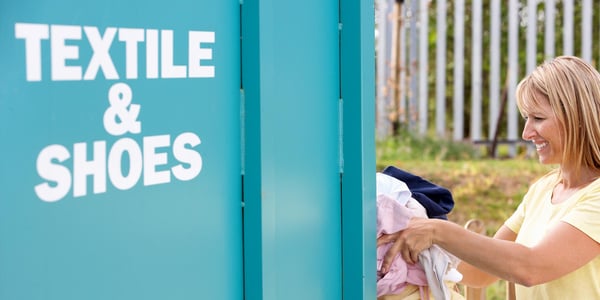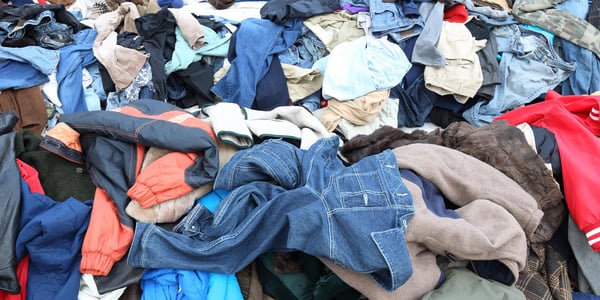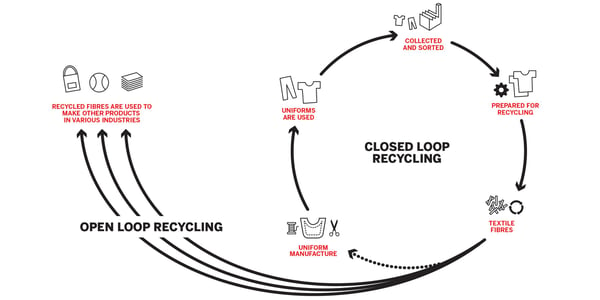The Future Lies in Closed-loop Textile Recycling
For closed-loop textile recycling to work and elevate the clothing industry to a more sustainable position, you need three important ingredients – incentivised retailers, efficient collection systems and consumers willing to participate in the program.

As uniform manufacturers and suppliers, with many on the team having a long history in retail, we understand the incredible wastefulness of the textile industry. With 20 million tonnes of garbage going into Australian landfill each year – 501,000 tonnes of that are textiles.
Some global estimates are suggesting that people discard approximately 10kg of clothing each year – most of which is going to landfill. Add to that your corporate uniform which is typically replaced annually and that’s a lot of waste!
“Fast fashion” is responsible for an excessive amount of waste as garments are typically discarded after a short time. The average return rate in the fashion industry is between 25% and 50% – which is alarming really because the majority of this is usually destroyed rather than being returned to stock and re-sold.

Imagine if new clothes were made from old clothes. Any textiles that were no longer needed were broken down via an environmentally-friendly “closed loop” process and made available to the manufacturing industry as recycled fibres, yarn or fabric. Imagine if retailers where incentivised to make this a priority in their business. Things could turn around quickly.
The focus should be on how to ensure that a higher number of textiles are recycled across all industries. Despite being in its infancy in Australia, the technology to “close the loop” is already out there to make this happen - and it’s scalable. It's important to mention that not all fabrics are able to be fully recycled. Cotton and Viscose are the most suitable for full circle textile recycling.
This technology makes “closed loop recycling” or “circular textiles” more accessible. As many of the challenges of textile recycling are being solved with clever technology, including separating dyes, blended fibre garments and other contaminants. The technology enables us to achieve fibre that has the potential to live on in another garment – fibres that have comparable quality to virgin-derived fibres.
What is closed-loop textile recycling?

- The garment is collected and the material is prepared before it is reduced into pulp.
- The pulp is then turned into fibres, which are used to make yarn.
- Woven fabrics are then made from the yarn.
- The fabric is then purchased to use to make new garments, which are purchased by consumers.
- When the consumers have used the garment, the garment is collected and sorted before being prepared for recycling.
How does this differ from open-loop recycling?
Open loop recycling is typically used when the garment is not suitable or unavailable for closed-loop recycling and is “down-cycled” into lower value products. In these cases the recycled textiles are shredded to be used in third-party markets and turned into another product other than what it was originally. Carpet underlays, furniture stuffing or industrial wipers are typical products that use recycled material – albeit only for a second use. This has enormous appeal, and a great way to recycle bulk textiles, however they tend to have a limited lifespan. When the end product is eventually replaced, this material typically goes into landfill anyway.
From a consumer standpoint, not much needs to change. One of the crucial parts of this equation is the collection model for the recycled garments. Many retailers and companies already have successful collection processes in place, and when customers are engaged and provided with an easy way to return the garments for recycling it works beautifully.
Where to from here?
As more and more apparel is produced to cater to the consumption preferences of an ever-growing population, it will put considerable pressure on our water supplies, co2 emissions, chemical use and disposal. This is not a sustainable process.
Closed-loop recycling presents an exciting economic opportunity for innovative textile recyclers and manufacturers.
Who knows, one day we might even see a community recycling program put in place so consumers can sell back their unwanted textiles – much in the same way we do with glass and plastic.
As we look to the future, it is our great hope that closed-loop and circular textiles practices are commonplace across all industries – particularly the corporate uniform and workwear industry. If you are interested in a uniform recycling program for your staff uniforms, read our latest blog or get in touch with our team.

